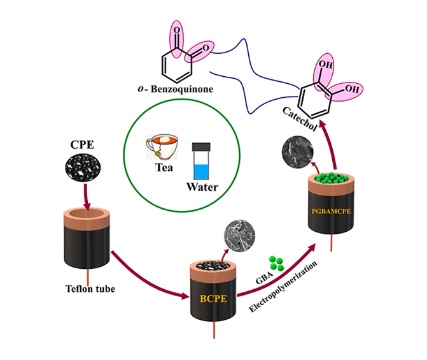Highly Selective and Sensitive Voltammetric Method for the Detection of Catechol in Tea and Water Samples Using Poly (gibberellic acid)-Modified Carbon Paste Electrode
Graphical abstract

Abstract
Despite the wide range of applications of catechol (CC) in agrochemical, petrochemical, textile, cosmetics, and pharmaceutical industries, its exposure to the environment leads to health issues as it is carcinogenic. This increased the concern over the risk of exposure level of CC in the environment, and monitoring its level has become critical. In this work, we report the fabrication of poly-gibberellic acid-modified carbon paste electrode (PGBAMCPE) to be a simple, viable, and effective electrochemical electrode for the determination of CC. This was synthesized by a simple electropolymerization method by the cyclic voltammetry (CV) technique. The electrodes were characterized by field emission electron microscopy, energy-dispersive X-ray spectroscopy, and electrochemical impedance spectroscopy. Compared to the bare carbon paste electrode, the sensitivity for CC fortified at PGBAMCPE in both CV and differential pulse voltammetry (DPV). We succeeded attaining a lower detection limit of 0.57 μM by the DPV method. The developed electrode was observed to be highly conductive, transducing, stable, and reproducible and was highly selective with anti-interfering properties from the determination of CC with hydroquinone simultaneously. The applicability of the electrode was confirmed from the detection CC in tea and water samples with good recoveries. This substantiates that PGBAMCPE is promising and consistent for the rapid monitoring of CC-contaminated area and clinical diagnosis.

The increasing demand for sustainable energy sources has spurred research into advanced energy storage technologies, with supercapacitors showing significant promise.

This investigation examined the combustion characteristics of ammonia/methanol blends under varying conditions of hydrogen enrichment, comparing direct hydrogen additon against ammonia cracking. …

The focus in recent years has been on developing innovative, green technologies for energy production and storage. Nanocomposite materials are attractive due to their exceptional performance,…

